The Age Old Question: When to Lift – Before or After Practice?

The Age Old Question: Lift Before or After Practice?
For almost any dedicated swimmer of a certain age, dryland and weight routines are familiar concepts. They have become mainstays in club and college programs as they provide clear benefits to athletes; the most prevalent being explosive power and endurance, as well as a decreased risk of injury.
However, no one seems to agree when the out-of-water workout should take place. Placing the dryland before swim practice and placing the dryland after swim practice both have their attractors and drawbacks. Let’s try to get to the bottom of this decisive issue.
Reasons to Lift Before Practice
To start this list off, the most common reason for lifting before a practice is convenience. Especially in college, where athletes have class schedules to follow, lifts can be tough to schedule to ensure 100% attendance. The easiest way to combat this problem is to lift in the morning before classes start. For example, the Tufts University swim team lifts in the morning from 6:45 to 8:00. It is the only time in the day where the varsity gym is open and the entire team is available.
Of course, this could be an issue if morning is normally when doubles take place for the program in question. Additionally, if the athletes swim directly after a morning lift session, their muscles will be warmed up and less injury prone.
Some athletes say that they swim slower after lifts and that point can’t really be denied. But, having more strength for lift, an activity which requires more physical strength than swimming, can make your lifts much more effective. Also, swimming while muscularly fatigued can be good throughout the week. Practicing holding solid form while tired is a skill that all high-level swimmers need.
Reasons to Lift After Practice
First, athletes will have more energy for swim practices when practice comes before dryland. Also, if a morning practice and an afternoon lift were run, one could take a nap between the two sessions. This would allow the athletes to recover from swimming to lift. If you had lifted in the morning, you still might be sore for swim practice in the afternoon.
This concept brings us back to one of the most important things about scheduling. When designing a practice schedule, a coach has to consider how the athletes will feel. One of my coaches told me this: it is much better to have a swimmer mildly upset over a bad lift than distressed over a bad practice. Swimmers are swimmers first, and lifters second. At the end of the day, swimming a bad practice because of lift can cause a much more substantial hit to their self-confidence than having a sub-par lift because of practice.
An Individual Choice
Of course there are pros and cons to each side of this argument, as well as other variables (pool space, gym space, and athlete schedules) that makes this decision for coaches difficult. However, keep in mind that as long as athletes keep a high level of focus during practice and dryland, great things will come.



